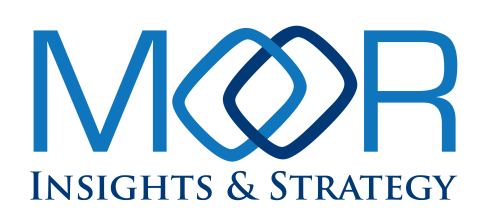
Welcome to this edition of our analyst insights roundup, collecting some of the key insights our analysts have developed based on the past week’s news.
Anshel Sag, our principal analyst for mobile devices and personal computing—and a terrific photographer—made this glorious panoramic photo of Petco Park in San Diego using Google’s new Pixel 9 phone. (You can read his review here.) Unfortunately, his beloved Padres—also the hometown team of our VP and principal analyst Melody Brue—lost their National League Division Series to the Dodgers.
It’s another busy week for our team!
This week, the team is attending various tech events nationwide. Melody is at AdobeMAX in Miami, while Matt, Paul, and Anshel are in Bellevue, Washington for Lenovo’s Global Analyst Summit & Tech World. New York is home to two significant events: Will is at Blackberry’s Analyst Day, and Matt, Robert, and Jason are participating in IBM’s Analyst Day.
On Thursday, October 17, Melody will join the RingCentral team on the webinar “Revealing the AI Communications Strategies That Work” where she’ll share her vision for the future of AI in UC. It’s free to attend!
Last week was very productive, with team members covering multiple events. Robert visited Los Angeles for Teradata, and Melody attended Zoomtopia in San Jose and SAP TechEd virtually. Bill was in Austin for Embedded World NA. Will traveled to Las Vegas for MWC Americas and the T-Mobile for Business Unconventional Awards. Patrick, Anshel and Matt took part in AMD’s Advancing AI Event in San Francisco, while Jason and Robert were in Seattle for the AWS GenAI Summit.
Looking ahead to next week, the team continues its tech event travels. Patrick and Will are set to attend Qualcomm’s Snapdragon Summit in Maui, Melody returns to Florida for WebexOne in Ft Lauderdale, and Matt will attend the RISC-V Summit virtually.
Our MI&S team published 15 deliverables:
Over the last week, our analysts have been quoted multiple times in top-tier international publications with our thoughts on Adobe Express, AI networking, AMD, Astera Labs, AI, Marriott, cybersecurity, NVIDIA, Samsung, the 5G Americas Summit, and T-Mobile.
MI&S Quick Insights
The other day I had a great talk with Diya Wynn from Amazon Web Services. Wynn has been a key evangelist on setting up guardrails for generative AI. AWS’s own Amazon Bedrock Guardrails is a very interesting service that enables responsible AI that can span multiple LLMs in an enterprise. However, Wynn recently took on an expanded role in AWS’s advocacy for responsible AI, in which she is helping educate both federal and state governments in shaping good AI policies. What stuck out from the conversation is that AI has some unique properties when it comes to governmental policies. The first is that the pace of innovation for GenAI has been faster than many new technologies, which is tough for governments to handle as they tend to move much slower. The second are concerns associated with possible AI future outcomes including job losses or civil upheaval. The best part was a discussion about the role the government plays in innovation and the potential for providing the right infrastructure (such as an updated power grid) so that AI can continue to grow. Technologists don’t always appreciate this type of collaboration, but I think it’s great that AWS is taking this on.
A hot topic last week was the pricing models used for AI agents. There are many different approaches out there. For instance, with its Agentforce offering, Salesforce will be charging a fee for every time an agent runs. Others will still use a capacity-based model or a per-user subscription. While the merits of each of these can be debated, a more critical nuance in all of this is whether vendors will be able to execute these strategies from a systems or relationship management perspective. It’s going to be a challenge for everyone moving forward.
The other day I had a great talk with Diya Wynn from Amazon Web Services. Wynn has been a key evangelist on setting up guardrails for generative AI. AWS’s own Amazon Bedrock Guardrails is a very interesting service that enables responsible AI that can span multiple LLMs in an enterprise. However, Wynn recently took on an expanded role in AWS’s advocacy for responsible AI, in which she is helping educate both federal and state governments in shaping good AI policies. What stuck out from the conversation is that AI has some unique properties when it comes to governmental policies. The first is that the pace of innovation for GenAI has been faster than many new technologies, which is tough for governments to handle as they tend to move much slower. The second are concerns associated with possible AI future outcomes including job losses or civil upheaval. The best part was a discussion about the role the government plays in innovation and the potential for providing the right infrastructure (such as an updated power grid) so that AI can continue to grow. Technologists don’t always appreciate this type of collaboration, but I think it’s great that AWS is taking this on.
A hot topic last week was the pricing models used for AI agents. There are many different approaches out there. For instance, with its Agentforce offering, Salesforce will be charging a fee for every time an agent runs. Others will still use a capacity-based model or a per-user subscription. While the merits of each of these can be debated, a more critical nuance in all of this is whether vendors will be able to execute these strategies from a systems or relationship management perspective. It’s going to be a challenge for everyone moving forward.
Evaluating large language models is important for determining their capabilities and effectiveness. Traditionally, though, this evaluation has required a reliance on human judgment or expensive manual annotations. A group of academics have now published a research paper that addresses these challenges with a process called TICK (for “Targeted Instruct-evaluation with Checklists”). TICK is an automated and interpretable evaluation protocol that utilizes LLMs to generate instruction-specific checklists that break down complex instructions into yes/no questions, making the evaluation process more structured and objective.
The checklist format provides a clear and understandable breakdown of the evaluation criteria. TICK has been shown to significantly increase the agreement between LLM judgments and human preferences. It also streamlines the evaluation process by automating checklist generation. Having a structured checklist format reduces subjectivity, improves consistency in evaluations, and provides insights into the LLM’s reasoning and understanding of instructions.
Tesla’s We Robot event finally showed to the world where Tesla is going with its autonomous vehicles and its robotics Optimus platform. Based on the market’s reception on Friday, it seems that people are not convinced of Tesla’s timelines or the viability of its autonomous vehicles, especially since the vehicles will be two-seaters—compared to Waymo’s five-seaters. Additionally, Waymo is already delivering 100,000 rides per month and continues to scale up every month at an even higher pace. I believe that Tesla’s offering is too little too late, and that a two-seater is not a great fit for many applications. That said, pricing will be important. Additionally, Tesla neglected to mention that most of the Optimus robot demos it showed people were not powered by AI, but instead teleoperated by pilots offsite. Robotics has a long way to go, but it’s quite disingenuous of Tesla to present its robots that way.
AWS and Salesforce have teamed up to offer a new contact center solution that integrates Salesforce Contact Center with Amazon Connect. This partnership aims to make it easier for businesses to implement and manage their contact center operations, with a focus on faster deployment, reduced complexity, and improved AI capabilities. Essentially, it combines the strengths of Salesforce’s CRM with Amazon’s cloud-based contact center technology. This move also reflects a broader trend of closer integration between CCaaS (contact center as a service) and CRM platforms, driven by customer demand for more unified and efficient solutions.
At its Advancing AI 2024 Event, AMD officially launched the 5th Generation EPYC processor, codenamed “Turin.” Turin launches at a time when AMD has seen its share of the server CPU market increase to 34% and its chief rival, Intel, looking to find its footing. 5th Gen EPYC will launch in two variants. One of them, labeled 5c, targets scale-out and cloud workloads with up to 192 cores; the other, labeled 5, addresses traditional scale-up workloads with up to 128 cores. As expected, the chip will ship with a richness of capabilities: 12 channels of memory, 128 lanes of PCIe, enhanced security, and up to 5GHz clock speed. Also as expected, the OEM community was lined up to talk about their partnerships with AMD.
Having gone through the initial launch of EPYC back in 2017, I think it’s incredible to see how the tides have turned. In 2017, Opteron (EPYC’s predecessor) had less than 2% market share. The number of OEM platforms it secured were just a few. Enterprise customers wouldn’t even take a meeting with the company. Fast-forward seven years and this 34% market share means that AMD’s datacenter business is contributing half of the revenue to the company. More than 950 cloud instances are powered by EPYC, and more than 350 OEM platforms are built on this processor. And the EPYC is just starting to penetrate the enterprise, as most of its success so far has been found in the hyperscale space.
The wind is at AMD’s back. Congratulations to the team—from the design engineers to the marketeers.
In addition to EPYC, AMD also launched its Instinct MI325X GPU, targeting the AI training and inference space as well as the HPC market. Along with the MI325X comes ROCm 6.2—the company’s software stack that enables customers and ecosystem partners to build on top of the Instinct GPU. Like 5th Gen EPYC, the MI325X ships with lots of memory (256GB HBM3E), lots of memory throughput (6TB/s), and incredible performance. So much so that the company is able to demonstrate inference advantages over the market leader, NVIDIA. Additionally, the company is showing near parity on the training front.
Even though we always view benchmark and performance claims with a tinge of cynicism, the fact that AMD is able to demonstrate leadership in some applications is a big deal.
I think that what the company is doing with ROCm is perhaps the biggest enabler for Instinct MI325X’s success. With ROCm 6.2, the company has not only simplified the process of developing software for AMD GPUs, but also greatly increased performance. In fact, when comparing against ROCm 6.0, the company is claiming a 1.8x improvement in training performance and a 2.4x improvement in inference.
At the event, AMD brought out partners such as Oracle and Meta to demonstrate the growth of Instinct in the market. It is clear this GPU is making both performance and market share gains against NVIDIA.
At the Commvault SHIFT event in London, the company made several announcements, including the launch of Cloud Rewind, a cyber resilience solution built on technology from its acquisition of Appranix. This feature gives organizations enhanced, automated recovery capabilities, allowing them to quickly rebuild cloud applications after an attack. Commvault also introduced enhanced solutions for Amazon Web Services users, offering direct support for AWS environments to improve the protection of Amazon S3 data, as well as protection for Google Workspace, including Gmail, Google Drive, and shared drives. Additionally, Commvault’s partnership with Pure Storage adds an extra layer of security for enterprises using Pure’s storage solutions, while the company’s recent acquisition of Clumio further strengthens its capabilities in AWS environments. For more details, check out my latest Forbes article, co-authored with Patrick Moorhead, CEO and chief analyst of Moor Insights & Strategy: Commvault Enhances Cyber Resilience With Cloud-First Focus.
Marriott Hotels suffered three significant data breaches between 2014 and 2020, affecting over 344 million customers, partially due to its acquisition of Starwood Hotels & Resorts. The company has since settled with the Federal Trade Commission and nearly all U.S. states. However, some cybersecurity experts are raising concerns over the terms of these settlements. Check out the linked article, which includes my thoughts on the impact and broader implications of the Marriott breaches.
At SAP TechEd 2024, SAP announced updates to its AI capabilities, focusing on its generative AI copilot, Joule. Joule will now include AI agents that can collaborate to automate complex tasks such as dispute resolution and financial accounting. This move towards increased automation aligns with the broader trend of AI impacting entry-level jobs; McKinsey estimates that 12 million jobs may be affected by 2030. While SAP emphasizes increased efficiency and employee focus on less repetitive tasks, the potential for job displacement due to AI, even in white-collar roles, should be considered. SAP is also introducing a Knowledge Graph solution to link data with business context, aiming to improve decision-making and AI development. These changes and new AI features for developers in SAP Build show SAP’s ongoing efforts in business AI.
In addition, SAP has already achieved its goal of upskilling 2 million people worldwide by 2025. This milestone suggests a commitment to addressing the digital skills gap and preparing the workforce for a future where AI plays a more significant role in various jobs, potentially mitigating some of the displacement caused by AI-driven automation.
Adobe has introduced a new tool to increase transparency and trust in digital content. The Content Authenticity web app, scheduled for public beta release in Q1 2025, allows creators to attach Adobe’s Content Credentials to their work, providing verifiable information about the content’s origin and edit history. With this initiative, Adobe seeks to address concerns surrounding misinformation and unauthorized content use, particularly in the context of rising AI-generated content and deepfakes. The app also offers creators greater control over how their work is used, including the ability to specify whether it can be used for AI model training. Additionally, Adobe is releasing a Content Authenticity extension for Chrome (available in beta now) to enable users to view these credentials easily. While this tool’s full impact and uptake remain to be seen, the tool represents a significant step towards fostering a more accountable and transparent digital media landscape. Currently, creators can utilize Content Credentials within existing Adobe Creative Cloud applications.
Smartsheet has updated its work management platform with a focus on improving user experience and adding new features such as “collections” for secure file sharing and a “file library” to simplify collaboration. The platform has a new look, with better data visualization tools and an improved table view for working together in real time. These changes align with Smartsheet’s focus on growing subscription revenue and expanding its customer base. By making the platform more user-friendly and efficient, the company should attract new users and encourage existing ones to upgrade or renew their subscriptions to access advanced features.
Oracle announced new AI features for its Fusion Cloud Service and Field Service, emphasizing a shift in service organizations. Jeffrey Wartgow, VP of product management for the Oracle CX Service, stated that these AI tools will transform, not replace, service teams. “Workers will curate knowledge, optimize automation, and address AI failures,” Wartgow explained, highlighting the need for human intervention in complex situations. This marks a shift towards proactive service design, demanding more strategic and analytical service teams.
Oracle also affirmed its commitment to accessible AI, including these advancements in existing service licenses. “We want service costs to go down,” Wartgow said. These new capabilities empower organizations to balance automation with a human touch, which should provide efficient customer service.
Last week I attended Teradata’s Possible 2024 event in Los Angeles as well as the AWS Analyst Summit in Seattle. Part of the focus was on managing the challenges that AI and data present across different industries. AI is projected to contribute $15.7 trillion to the global economy by 2030. At the same time, 65% of executives prioritize sustainability, emphasizing the need to align AI’s growth with environmental goals. Effective data management is huge, as 80% of businesses report revenue increases from real-time analytics. While many vendors claim to offer sustainability solutions, the question remains whether these solutions address the full scope of customer needs for end-to-end carbon footprint transformation. This involves the entire production cycle—from sourcing raw materials to operational processes, transportation, and waste management—affecting all departments, suppliers, partners, employees, and customers. Additionally, companies must navigate the external factors of regulations and public reputation. I’ll be providing further analysis on sustainability’s impact on industries in my areas of specialty.
The AWS Analyst Summit was a great preparation for the upcoming AWS re:Invent conference. There was an informative discussion on Amazon Q, AI, data, ERP, SCM, and industries (specifically automotive). More to come on this in December when re:Invent rolls around.
Cloudera has announced its AI Inference service, powered by NVIDIA NIM microservices as part of the NVIDIA AI Enterprise platform. This service enables enterprises to efficiently deploy and manage large-scale AI models for both on-prem and cloud workloads to deliver on the potential of GenAI from pilot phases to production. Key features include auto-scaling, high availability, real-time performance monitoring, and integration with CI/CD pipelines via open APIs. The service also ensures strong enterprise security with access control and auditing and supports controlled updates through A/B testing and canary rollouts, providing a scalable and secure AI deployment solution.
Qualcomm recently announced its Networking Pro A7 Elite platform, which infuses GenAI and Edge AI with Wi-Fi 7. Users stand to benefit from performance improvements as well as personalized application and service delivery. What stands out for me is the ability to use the Edge AI feature to support privacy controls on infrastructure, potentially enhancing security outcomes by complementing endpoint protection.
XBOX Cloud gaming will let users stream their own games starting in November. This means that users will be able to stream games beyond the XBOX Game Pass Library, making the service even more useful to gamers who might have quite a broad library of titles. I believe that this is a sensible continuation of Microsoft’s expansion of capabilities for its XBOX gaming services. It also comes right on the heels of a court ruling in an Epic Games case that forces Google to stop requiring Google Play billing for apps in the Play Store starting on November 1.
EWNA — I attended the inaugural Embedded World North America conference in Austin last week. Embedded World is now international, with 2024 conferences in Nuremberg, Shanghai, and Austin. With about 3,500 attendees and 180 exhibitors, the inaugural EWNA offshoot was much smaller than its parent Nuremberg conference (32,000 attendees). Still, I was impressed with the coverage and quality of EWNA presentations, exhibitors, and attendees. In engineering terms, the conference’s signal-to-noise ratio was excellent. The second EWNA conference is slated for next year in Anaheim, California, and I plan to be there.
Silicon Labs CEO Matt Johnson and CTO Daniel Cooley delivered the opening keynote at EWNA. I agree with Johnson’s list of four developments that determine IoT’s potential: (1) robust platforms, (2) business models with significant ROI, (3) connectivity (with Matter and Sidewalk as examples), and (4) symbiosis between AI and IoT. This analysis set the stage for the introduction of the company’s Series 3 SoCs. Series 1 optimized embedded processing, Series 2 added connectivity, and Series 3 is a complete IoT platform built for inferencing, with post-quantum security and extensible memory and storage. Cooley gave us one of the best quotes from EWNA: “You can’t scale IoT on bare metal.” To show that Silicon Labs is all-in on platform-based IoT, he held up a sample of a new 22nm Series 3 chip. Embedded product companies that use off-the-shelf RTOSes (and OSes) pre-integrated with silicon platforms can concentrate on writing application code and minimize (or eliminate) the cost, time, security risks, and technical debt of creating custom system software. The economic benefits of this strategy outweigh the additional hardware cost for all but the most cost-constrained, power-limited, or air-gapped products. The company published technical details about Series 3, and I’ll provide insights in future posts and papers.
Qualcomm hosted an Embedded World NA event to introduce “The Age of Industrial Intelligence.” Nakul Duggal, general manager of the company’s automotive, industrial, and cloud business, walked the audience through the company’s industrial IoT strategy in detail—architecture, technologies, connectivity, processors, and AI platforms (Qualcomm IQ series). I was impressed with the company’s sharp focus on key vertical industries. IoT is a large set of horizontal technologies that are customized and sold into vertical markets. Most of the ingredient technologies are mature, but not the customization step. Customization is responsible for most of the cost and complexity of IoT deployments. To address this shortcoming, Mr. Duggal introduced the “chassis” concept—a set of use cases, products, enabling technologies, development tools, and system software unique to each vertical industry. The catchphrase “Industrial chassis for every vertical” means that each chassis supports customer-specific adaptation and differentiation, much like a car chassis supports multiple bodies. This approach reduces the need for extensive industry-specific and customer-specific development, and Qualcomm’s impressive list of “scaling partners” confirms the attractiveness of this approach. I’ll have much more to say about this in a future article.
Qualcomm and STMicroelectronics announced a strategic collaboration agreement that combines STM’s microcontrollers with Qualcomm’s wireless connectivity solutions. STM plans to start with a modular approach, integrating Qualcomm Wi-Fi/Bluetooth/Thread combo SoCs with various STM32 microcontrollers. While STM’s existing portfolio offers Thread and Bluetooth combinations, Qualcomm integrates all three into a single solution with coexistence logic. The first wave of collaborative products hits the market early next year, and STM aims to extend the roadmap “over time” to include cellular connectivity for industrial IoT applications. The combined products fill STM’s connectivity gaps and add mature microcontroller options to Qualcomm’s portfolio.
NXP recently hosted a Smart Home Innovation Lab tour on the company’s Austin campus. NXP has long recognized the importance of multi-vendor interoperability; it sponsored Thread and Matter from the start, and is now funding the hard work required to break down the deployment and usability barriers that impede growth in smart home technology.
Google has launched NotebookLM, an experimental AI tool that converts documents into engaging podcasts, offering a new way to consume information. The AI technology summarizes documents and generates discussions hosted by AI voices, making even complex texts such as legal briefs and academic papers more accessible for those who prefer auditory learning or have limited time. However, users should be aware of potential inaccuracies and biases in AI-generated summaries. Inaccuracies can range from subtle misinterpretations of the original text to outright hallucinations of information, particularly with nonfiction content. Beyond addressing these concerns, it seems like a fun tool, and I’m looking forward to trying it out.
Many in the tech industry, including at Google itself, seem to think that the breakup of the company is coming due to actions by regulators in the U.S. and Europe. This breakup would force Chrome and Android to be set apart from the company’s search business to avoid anticompetitive behavior where the company may prefer its own services above others. While it remains to be seen how this would work, I have been getting a sense that the company is already compartmentalizing certain apps and services in a way that would prepare it for such a split. Although Google would become a smaller company if this did come to pass, I also think it would potentially allow the company to focus on other businesses and give it a chance for more growth.
To demonstrate the superior speed and circuit quality of its Qiskit software stack for quantum computing, IBM recently conducted extensive tests against leading quantum software development kits. Qiskit was the overall obvious winner; it was faster, successfully completed more tests than any other SDK, and created circuits with fewer two-qubit gates. More specifically, Qiskit was 13x faster and 24% more efficient than TKET, which was the second-best-performing SDK. Even better, IBM is releasing a benchmarking open source suite called Benchpress that will allow users to perform their own performance evaluations and gain important insights about how other SDKs perform relative to Qiskit. (For more on IBM’s work with Qiskit, you can check out my recent article in Forbes.)
Quantinuum researchers have developed a method for gradient computation of quantum algorithms implemented on linear optical quantum computing platforms. Photonic quantum computers use photons to perform calculations, and it is difficult to calculate the mathematical gradient values needed to find the best way to improve the performance of these computers. Methods normally used for calculating gradients in gate-based quantum computers don’t work with photonic computers because of the special properties of light being used. Quantinuum researchers used a photonic parameter-shift rule to overcome this limitation and provide gradient computation for linear optical quantum processors.
The new method is efficient because the amount of work required is directly proportional to the number of photons being used. It also works well with VQA, an algorithm that can be optimized using gradients. The researchers tested the new method on quantum-chemistry and generative-modeling tasks and determined it performed better than other gradient-based and gradient-free methods. Although Quantinuum’s primary interest is trapped-ion quantum computers, it is possible it could be interested in using photonics for transmitting quantum information over long distances. Quantum computers can act as powerful nodes in a quantum network.
Intel is leaning into its extensive research efforts, silicon depth, and strong ecosystem and partnerships to deliver silicon-level secure AI at scale. In doing so, the company is providing enterprises with the ability to extend protection for datacenters and clients from cloud to network edge with both hardware and software. The success of Intel’s efforts can be measured by significant improvements in security controls, as well as the higher resilience of new AI PCs and datacenter applications. I recently published a Moor Insights & Strategy research paper that goes into more depth on Intel’s secure AI efforts.
MediaTek’s new Dimensity 9400 has adopted the latest Arm v9.2 CPU cores as well as GPU IP from Arm. The new chip also follows the Dimensity 9300 in abandoning the “little” cores and going with all-“big”-core designs. This does have a small impact on battery life, but because the big cores have become so power-efficient, the difference is negligible and results in better CPU benchmark performance, with MediaTek clocking up to 3.63 GHz on TSMC’s N3E process node. The result is a staggering increase over the Dimensity 9300 of up to 35% in single-core performance and 28% in multicore performance. The GPU is also expected to be up to 41% faster, while also boosting ray tracing performance by 40%. Although it isn’t built on Arm IP, the NPU is also improved, with 35% better energy consumption. Overall, the Dimensity 9400 looks to be yet another competitive flagship offering from MediaTek, and I expect we’ll see designs from Chinese OEMs using this chip very soon.
AMD launched the new Ryzen AI Pro 300 series at its Advancing AI event, after it sort of already launched it with HP last month without fully unveiling it. At the event, AMD also announced a new design with Lenovo for the storied ThinkPad line, which is a huge win for AMD to improve the enterprise credibility of the Ryzen Pro line. AMD also says that it has more than 100 design wins with the Ryzen AI Pro line through the end of 2025, which could potentially take a chunk of market share from Intel if units move in volume next year, aligned with the end of Windows 10 support.
Amazon Web Services has announced that it will remain the Seattle Seahawks’ official cloud provider, as well as its partner for machine learning, artificial intelligence, and generative AI. As the world of sports continues to embrace tech innovation, the Seahawks can take advantage of AWS’s breadth and depth of technologies. The Seahawks will use AWS’s Bedrock AI-powered system to automate content distribution by transcribing, summarizing, and distributing press conferences to millions of fans across online, social, and mobile channels in English, German, and Spanish.
T-Mobile recently announced a 5G on Demand solution that is designed to make it easier to deploy cellular infrastructure for portable use cases. The applications are limitless, including pop-up retail, special events, and more. The company claims that the private cellular network platform can be deployed in under 48 hours, and it is expected to be commercially available by the end of the year. T-Mobile has already leveraged the core components of 5G on Demand to support recent PGA men’s and women’s events, and at MWC Las Vegas 2024, T-Mobile for Business awarded CBS and Sony a first-place prize at its Unconventional Awards event to recognize the accomplishment.
Forbes Articles Published
- Cadence Launches Fem.AI to Close the AI Gender Gap (Melody Brue)
- Pixel 9 Review: Perhaps the Best Pixel Ever Made (Anshel Sag)
- Commvault Enhances Cyber Resilience with Cloud-First Focus (Patrick Moorhead, Robert Kramer)
- VAST Data Deepens Its AI Enablement with InsightEngine (Matt Kimball)
Research Papers Published
- Intel Secure AI (Will Townsend, Patrick Moorhead)
- Zscaler — Empowering Defenders with Zero Trust and AI (Will Townsend, Patrick Moorhead)
Podcasts Published
MI&S DataCenter Podcast (Will Townsend, Paul Smith-Goodson, Matt Kimball)
The G2 on 5G Podcast (Will Townsend, Anshel Sag)
Six Five (Patrick Moorhead)
- Six Five, Episode 236: We are Live! Talking AMD, NVIDIA & MediaTek, Apple, Amazon, Tesla, Commvault
- CIO Insights & Strategies for AI PCs (Patrick Moorhead)
- Six Five On the Road: Scaling AI with Astera Labs’ Smart Fabric Switch Portfolio (Patrick Moorhead)
- Six Five: Shifting to Cloud-First Cyber Resilience with Commvault — at Commvault SHIFT (Patrick Moorhead)
- The Six Five: Talking Vast Data, Robotic Ports, Nvidia-Accenture, iPhone, GenAI, AMD, Qualcomm, Intel, Microsoft (Patrick Moorhead)
- Six Five: Reinventing DDI for the Hybrid, Multi-Cloud Era (Patrick Moorhead)
Don’t miss future MI&S Podcast episodes! Subscribe to our YouTube Channel here.
Citations
Adobe / Adobe Express / Melody Brue / CFO Tech
Adobe Express expands with AI & key integrations
Adobe / Adobe Express / Melody Brue / Mi3
Adobe Express expands enterprise capabilities, delivers new integrations with Slack, Box, Google and more
AI Networking / Will Townsend / SDX Central
Exploring the new world of AI networking
AMD / AI Chip / Patrick Moorhead / The Rio Times
AMD’s New A.I. Chip Announcement Leads to $11 Billion Market Value Drop
AMD / AI Chip / Patrick Moorhead / OpiniPublik
AMD reveals AI-infused chips within Ryzen, Intuition and Epyc manufacturers
AMD / AI Chip / Patrick Moorhead / Venture Beat
AMD unveils AI-infused chips across Ryzen, Instinct and Epyc brands
Astera Lab / AI / Patrick Moorhead / Street Insider
Astera Labs Introduces New Portfolio of Fabric Switches Purpose-Built for AI Infrastructure at Cloud-Scale
Marriott / Cybersecurity / Robert Kramer / CSO
Do the Marriott cybersecurity settlements send the wrong message to CISOs, CFOs?
NVIDIA / Stock / Patrick Moorhead / Yahoo! Finance
Nvidia stock eyes record high as AI boom continues
Samsung / 5G Americas Summit / Anshel Sag / Samsung
Samsung to Participate in 5G Americas Industry Analyst Forum
T-Mobile / 2024 Unconventional Awards / Will Townsend / Aventiv
T‑Mobile Celebrates Innovative Customers at Third Annual Unconventional Awards
TV Appearances:
AMD / AI Chip / Patrick Moorhead / Yahoo! Finance
Why Wall Street wasn’t excited by AMD’s new AI chip
New Gear or Software We Are Using and Testing
- Cisco Desk Pro (Melody Brue)
- OnePlus Buds Pro 3 (Anshel Sag)
- Insta360 Link2 4K AI Webcam (Anshel Sag)
- Pixel Watch 3 (Anshel Sag)
- Pixel 9 Pro Fold (Anshel Sag)
- Google TV streamer – Matter and Thread features (Bill Curtis)
- Various Matter devices (Bill Curtis)
- ASUS Zephyrus G16 Gaming Laptop (Anshel Sag)
- iPhone 16 Pro (Anshel Sag)
Events MI&S Plans on Attending In-Person or Virtually (New)
Unless otherwise noted, our analysts will be attending the following events in person.
- AdobeMAX, October 14-16, Miami (Melody Brue)
- Lenovo Global Analyst Summit & Tech World, October 14-17, Bellevue, WA (Matt Kimball, Paul Smith-Goodson, Anshel Sag, Patrick Moorhead)
- Blackberry Analyst Day, October 16, New York City (Will Townsend)
- IBM Analyst Summit, October 16-18, New York City (Matt Kimball, Robert Kramer, Jason Andersen)
- Snapdragon Summit, Maui, October 20-24 (Will Townsend)
- WebexOne, October 21-24, Miami (Melody Brue)
- RISC-V Summit, October 22-23 — virtual (Matt Kimball)
- Cisco Partner Summit, Los Angeles, October 28–30, 2024 (Robert Kramer)
- SAP SuccessConnect, October 28-30 – virtual (Melody Brue)
- Red Hat Analyst Day, October 29 (Matt Kimball, Jason Andersen — virtual)
- GitHub Universe, October 29-30, San Francisco (Jason Andersen)
- 5G Techritory, October 30-31, Riga (Will Townsend)
- AdobeMAX, October 14-16, Miami (Melody Brue)
- Lenovo Global Analyst Summit & Tech World, October 14-17, Bellevue, WA (Matt Kimball, Paul Smith-Goodson, Anshel Sag, Patrick Moorhead)
- Blackberry Analyst Day, October 16, New York City (Will Townsend)
- IBM Analyst Summit, October 16-18, New York City (Matt Kimball, Robert Kramer, Jason Andersen)
- Snapdragon Summit, Maui, October 20-24 (Will Townsend)
- WebexOne, October 21-24, Miami (Melody Brue)
- RISC-V Summit, October 22-23 — virtual (Matt Kimball)
- Cisco Partner Summit, Los Angeles, October 28–30, 2024 (Robert Kramer)
- SAP SuccessConnect, October 28-30 – virtual (Melody Brue)
- Red Hat Analyst Day, October 29 (Matt Kimball, Jason Andersen — virtual)
- GitHub Universe, October 29-30, San Francisco (Jason Andersen)
- 5G Techritory, October 30-31, Riga (Will Townsend)
- Dell Tech Analyst Summit, November 6-8, Austin (Matt Kimball, Anshel Sag, Paul Smith-Goodson)
- Apptio TBM Conference, November 4-5, San Diego (Jason Andersen)
- IBM, November 6-8, New York City (Paul Smith-Goodson)
- Fyuz, November 11-13, Dublin (Will Townsend)
- Veeam Analyst Summit, November 11-13, Scottsdale, AZ (Robert Kramer)
- Box Analyst Summit, November 12-13, San Francisco (Melody Brue)
- Microsoft Ignite, November 18-22, Chicago (Robert Kramer – virtual, Will Townsend – virtual)
- Super Computing, November 18-22, Atlanta (Matt Kimball)
- NTT R&D Forum, November 19-23, Tokyo (Will Townsend)
- AWS re:Invent, December 2-6, Las Vegas (Robert Kramer, Will Townsend, Jason Andersen, Paul Smith-Goodson, Matt Kimball)
- T-Mobile Analyst Summit, December 9-10 (Anshel Sag)
- Marvel Industry Analyst Day, December 10, Santa Clara (Matt Kimball)
- ServiceNow Global Industry Analyst Digital Summit, December 10 (Jason Andersen, Melody Brue, Robert Kramer – virtual)
- Acumatica Summit, January 26-29, Las Vegas (Robert Kramer)
Subscribe
Want to talk to the team? Get in touch here!






























































































